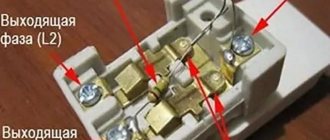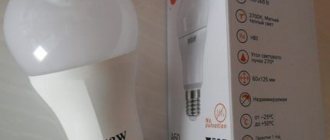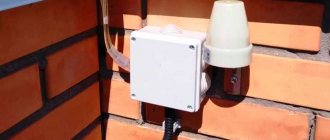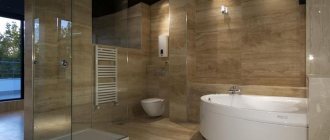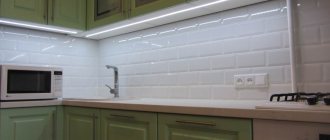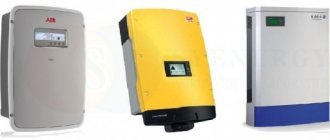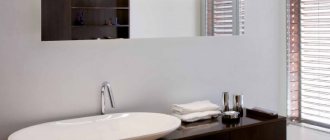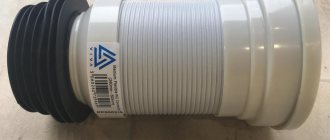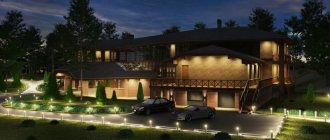Features of illuminated mirrors
A beautiful and correctly selected mirror is an effective and practical piece of furniture. The illuminated model is both decorative and functional. Anyone who decides to purchase such an accessory for their bathroom is interested in how it works and how safe it is in conditions of high humidity.
Typically, such mirrors have a plastic box attached to the inner surface. A lamp is placed around its perimeter or inside. The mirror is connected directly to the electrical cable or through a socket to a regular network. Inside the design there is a power supply that converts the voltage to 12 V.
By illuminating the mirror from the inside, the lamps ensure uniform distribution of light. A person does not have to strain his eyes, and the reflection is clearly visible.
Mirror set:
- lamps: LED, fluorescent, halogen, less often – neon;
- AC adapter or battery;
- mounting brackets.
Step-by-step instruction
Let's look at how to make LED lighting for a mirror with your own hands. Procedure:
- Develop a project or at least a working drawing. This point should not be treated as a waste of time, since careful consideration of details and advance calculation of all necessary materials and tools will help to quickly and efficiently complete the work and obtain the expected result.
- Assemble a box for the LED strip according to the size of the mirror. As a rule, it is a frame glued to the surface on the reverse side. Its size is 8-10 cm smaller on each side than the length and width of the mirror - this ensures hidden installation of the lamp. The easiest way to do this is to use duralumin corners or a rectangular pipe. Some difficulty will arise when cutting corners at 45°, which is best done on a pendulum machine or, which is somewhat worse, manually using a miter box.
- Drill holes in the top bar of the box (frame) for hanging on the wall. (This item is necessary if special fasteners or brackets are not used).
- Place the mirror on the front side. Glue the frame on the back side, ensuring an even distance from the edge on all sides.
- Glue LED lighting to the outer sides of the frame. You can use your own adhesive layer provided on the tape. Double-sided tape or waterproof glue will also work.
- Connect the parts of the tape with connectors, attach the wires and hang it on the wall.
- Connect the wires to the power supply, and connect the unit itself to the network. Use one of the options for turning on the backlight - either from a general light switch or from your own button.
- Perform a test run, and if any problems are detected, correct them using the appropriate method.
The specified procedure is given as an example; in each specific case, deviations or additional points are possible.
Advantages and disadvantages
Anyone who has once installed an illuminated mirror in their bathroom is unlikely to want to give it up.
Practical models with additional lighting look stylish and harmonious, fit into any interior, and allow you to evenly apply cosmetics or carry out hygiene procedures. And these are not all the strengths of such mirrors.
Their obvious advantages:
- Practicality . In a small room, especially in the bathroom, additional lighting comes in handy. Unlike main light sources, recessed lighting will not reflect in the mirror, cutting into precious space. The internal lighting does not take up additional space, and it provides the same amount of light.
- Mirror lighting divides the bathroom into zones and makes the room more stylish . Calm, soft light creates a cozy atmosphere and helps you relax.
- Even distribution of light . It will not be directed upward at an angle, but perpendicularly along the face. The lamps do not cast sharp shadows or glare on people and objects.
- Economical . Energy-saving LED lamps and strips are usually used for lighting. Unlike incandescent lamps, they consume much less energy and last longer.
- Versatility . Illuminated mirrors are easy to fit into different interior styles: from classic design to high-tech. They can decorate any room with their stylish design or become an independent accent.
- Easy installation . You receive a finished product, and all you need to do is hang the structure and connect it to a power source. No special skills in electrical installation are required, and all necessary fasteners are supplied by the manufacturers as a kit.
There are only two possible disadvantages of illuminated mirrors, and they are associated with illiterate choice:
- High humidity provokes the appearance of rust on lamps and parts with poor-quality protective coating. It’s easy to prevent the problem: just buy quality products from trusted manufacturers.
- Too bright light blinds the eyes . And it only occurs when the location of the lamps is incorrectly chosen.
For your information! Diffused, soft on the eyes, but quite bright light is provided by matte shades of outdoor lamps or matte diffusers for LED lamps. It is better to choose mirrors equipped with them.
Bathroom safety
As we mentioned above, all family members use the bathroom every day, and children are no exception. Therefore, this room should be as safe as possible.
Here are some recommendations to help you choose a good lighting fixture. When making a purchase, pay attention to the IP index. It is indicated by two numbers, which show how protected the lamp is from dust (first number) and moisture (second number). Obviously, for the bathroom it is the second indicator that is more important.
Decoding IP indices
Those devices that are designated with the IP 44 index are protected from splashes, and IP 55 means that they are not afraid of even a jet of water. So, the higher the indicator, the safer the lamp, and you don’t have to be afraid to place it close to the bathtub, shower stall or tap. But still, for the sake of compliance with safety rules, it is not recommended that the distance between a lighting fixture or socket and water sources be less than 60 cm and 200-250 cm above them.
Lamp L-trade 55 (IP 54)
Rondo ip 44 lamp
In addition, do not forget about grounding the metal parts of the lamp. In general, it is undesirable to use high-voltage appliances in the bathroom. The most suitable are 12 or 24-volt, because even in the event of a short circuit they cannot cause harm to a person.
Kinds
One of the main differences between the different models, apart from the shape, which can be varied, will be the type of lighting used. For mirrors, white cold, daytime and familiar warm spectrums are used. There are also models with color backlighting. Usually they perform purely decorative functions and have a separate switch.
Bathroom mirrors are available with the following types of lighting:
Internal
The light is directed from the mirror, evenly illuminating the face of the person standing in front of it. This is achieved using a frame through which rays of light of varying degrees of brightness pass.
External
The light is directed to the sides and scatters, reflecting from the walls. Looks like an even glow around the frame, this effect greatly decorates the bathroom interior.
Combined option
Uses both types of light direction. This achieves the highest quality lighting in combination with visual design.
Decorative
A type of internal illumination, only the glow is directed directly through the surface on which the ornament or design is made.
In addition to various options for light sources, several methods of equipping the switch are used:
A regular push-button one is located on the wall or on a frame - this option is convenient and familiar.
More expensive models are often equipped with a touch switch. The light comes on after touching any area on the surface of the mirror itself. There are models with a non-contact infrared sensor that reacts when your hand approaches the sensor. There is no need to touch the sensor, it works at a distance of up to 5 cm.
Mirrors can also be equipped with additional functions:
Watch
They are installed directly on the mirror surface so that you can monitor the passage of time in any room.
Heating
This is a system consisting of a film on which a thin heating cable is attached. Heating is used to prevent the mirror from fogging up while taking a shower.
Thermometer for monitoring room temperature
Vector image
To make them more decorative, mirrors are often complemented with an original design or logo, which also glows. There are a lot of options from inscriptions to complex compositions.
Mirror ends
This element of the mirror design hides part of the frame. If you look at the mirror from the side, you can see nothing but the reflection. A mirror with mirrored ends looks simply amazing.
Built-in magnifying mirror
This is very convenient and practical because it does not take up space as an additional separate element.
Socket
It can be built into the side part or into the visor and adjacent to point spots. If the mirror is combined with a cabinet, there may be several sockets. This solution will make the use of electrical appliances more convenient and will avoid the need to mount an outlet in the wall.
Radio
A godsend for those who like to soak in a bubble bath while enjoying melodic compositions. During morning procedures, you can also cheer yourself up with cheerful rhythms. Such devices have built-in speakers and Bluetooth, which makes it possible to configure using a smartphone or tablet.
Sophisticated fans of advanced technology can purchase a mirror with a built-in monitor and speakers. It can connect to WI-FI, and you can shower while listening to your favorite video clips.
How and from what to make a frame?
So, we’ve sorted out the surface preparation and contours, let’s move on to the frame.
In order for the mirror to have rigidity and be easy to wash, wipe, and hang on something, it is necessary to form a frame.
Mistake #6
Most often it is made from a profile, but not iron, but aluminum.
It is lighter, cools the tape better, and does not rust. This one is sold in construction stores, such as Leroy Merlin.
Some people use a single piece of chipboard. Then they sculpt an LED strip directly onto the end of this piece of wood.
Mistake #7
This way, of course, you will ensure the rigidity of the structure, but the cooling of the LED strip will not!
As a result, the LED strip will often fail and little depends on its quality.
And laminated chipboard can swell over time due to constant moisture, so an aluminum profile is the most successful solution for a bathroom.
For small mirror sizes, a 25mm*25mm profile is suitable.
Mistake #8
You shouldn’t take less, since this width provides the necessary gap between the wall and the mirror.
In this space you will have to hide both the touch button and the power supply, the minimum thickness of which is slightly more than 20mm.
If your block is much thicker or the mirror is larger, then accordingly choose a profile of a different width.
Criterias of choice
Purchasing a backlit mirror is a case where you shouldn’t save money. A low-quality product will not only not last long, but can also cause a fire and other disastrous consequences. Therefore, choose products from trusted manufacturers and check all the markings to once again make sure that the selected mirror is intended specifically for wet rooms.
The first thing to consider is the surface coating. It must be protected with special anti-fogging agents. A reflective substance is also applied to it, which determines the quality and service life of the product.
There are several types of spraying:
Aluminum . Used simultaneously with varnish. It has a low level of moisture resistance and is subject to even minor mechanical damage. It has a low price.
Titanium . Durable, gives the image a graceful bluish tint.
Copper or silver . The best, most durable and flawless coating.
When purchasing a mirror, it is also important to consider the following parameters:
Light direction
Before purchasing a model you like in terms of design, decide on the purpose of the lighting. It happens that it plays an exclusively decorative role; this area does not need additional lighting.
If there is not enough main light, and you need to illuminate the area near the mirror, then the choice will fall on completely different options and lighting for them: for daily procedures you need lamps that “look” at the center; when you need to highlight individual mirror elements, you can choose models with spotlights.
Lamp color
We are not talking about decorative colored lighting: it has purely design purposes. You need to understand the features of lamps that produce warm and cold light. Warm (yellow) – creates a feeling of warmth, coziness, comfort, but it may seem somewhat dull. The cool (white) spectrum is sharp. This leads to the fact that the image in the mirror is detailed, all the flaws are visible. But when applying makeup and shaving, this is exactly what you need.
Frame and fasteners
It is important to choose models with a frame that will withstand moisture. The best materials for this parameter are plastic and stainless steel. The fasteners must withstand significant loads. Most often it comes complete with a mirror.
The safety of operation and durability of the mirror directly depend on the fittings and fastening elements. When purchasing, you should immediately review the remaining components. If they are not trustworthy, you should immediately replace them with more reliable ones or abandon the chosen model.
Size and shape
For the bathroom, models with a height of 40 to 60 cm are most suitable. Hanging mirrors 120 cm or more is impractical. And in small rooms they will not be appropriate. Rectangular or square mirrors are considered universal in shape. There are also oval and round ones, as well as models with particularly elaborate shapes, but they are not suitable for every interior.
The perception of the room depends on the shape of the mirror: round ones make small bathrooms look larger, square ones visually make rectangular ones smaller and narrow ones, elongated ones visually raise the ceiling.
Lamp type
It is better to choose models that have built-in durable and at the same time economical lamps. Preference should be given to LED and fluorescent ones. They shine brightly, but not annoyingly. They consume a minimum of electricity.
Switch type
Few people pay attention to this detail when purchasing, and it’s completely in vain. The location and features of the switch are user comfort.
Presence of heating
This option adds cost to the mirror, but its presence guarantees no fogging.
Product thickness
It is better to choose models with a thick mirror surface. Thin distorts proportions and image. The best option is glass with a three-layer coating: first, silver reflective, then copper anti-corrosion, and finally paint that protects against mechanical damage.
Important! When purchasing a mirror, carefully inspect its surface and cut around the perimeter. They must be smooth, without cracks, scratches or chips. Reject the product if you find bubbles and raised areas on the surface - they will look even worse over time. For safety reasons, it is better to choose an object with rounded edges rather than sharp ones.
Avoid obvious contradictions
The decision to add additional light does not always come at the renovation stage. Sometimes you have to match it to an already purchased mirror. Of course, a person first of all creates an interior for himself and has every right to any combination of styles, sizes, shapes and materials. But it's best to avoid the following:
- too massive and bright lighting around the perimeter of the mirror for a small bathroom;
- the juxtaposition of colored neon lamps with a mirror in a frame with gilding or stucco;
- choosing a very cool light for classics;
- different geometry of the mirror and light source (for example, bell-shaped lampshades are not entirely appropriate next to a mirror that has clear lines and sharp corners);
- structures that will subsequently be difficult to clean from contamination.
Among bathroom furnishings, a mirror attracts more attention than, say, a sink or a towel rail. Often it is a kind of center of the composition, so the design of this zone should be approached especially carefully. In addition, properly selected lighting visually expands the room.
Modern industry offers such a variety of additional lighting solutions and types of lamps that the buyer today is often puzzled how to figure it all out.
Top best manufacturers
The modern market offers a wide selection of mirrors with built-in lighting. But not all manufacturers should be trusted, since quite high requirements are placed on this item.
According to customer reviews, models from the following companies have reliability and quality:
AM-PM
A brand that has gained popularity all over the world. The products of this company are appropriately labeled, their price is proportional to the quality of the products, which are represented by collections of furniture, bathroom fixtures and accessories, including mirrors.
AQUANET
Well-known manufacturer of accessories and furniture for bathrooms. The products are practical and functional. The company offers models in different price categories. Mirror surfaces are resistant to mechanical stress, have interesting shapes and different sizes.
Alavann
The company produces high-quality mirror surfaces according to individual sketches. The production uses wear-resistant materials, harmless paint, and fittings from well-known European companies.
Aquaton
It produces products from cast marble and high-quality three-layer mirrors that are resistant to temperature changes. The manufacturer guarantees strength, moisture resistance, and a 3-year warranty.
Triton
It produces bathtubs with acrylic coating of complex configurations and mirrors: ordinary, decorated, with shelves and cabinets, adapted for the “climate” of bathrooms. Provides a 5-year warranty on its models.
Jacob Delafon
A French company that produces durable mirrors that are resistant to mechanical damage. They have a thick layer of glass and reflect light efficiently.
Moidodyr
A proven domestic company with excellent recommendations on the market. Offers a wide selection of bathroom mirrors with built-in cabinets and lighting fixtures, convenient shelves and eye-catching decor.
Safety and Grounding
Safety and functionality are requirements for any wiring. Grounding is mandatory on all sockets and stationary electrical equipment. In addition, potential equalization is connected. Previously, when two-wire wiring was used, it was necessary to bring a separate ground wire to the panel. Now the cables are three-core, all devices are immediately connected to ground.
In a private house, you should take care of grounding yourself. 3 metal corners or pieces of reinforcement are driven deep into the ground. The elements are connected to each other by welding. The circuit is connected to the distribution panel with a steel wire on bolts and washers.
Application of RCD
Residual current devices are required for bathroom wiring. They break the power circuit if insulation breakdowns occur. Installed at the entrance to the shield. The rating of the common RCD for the group line is 30 mA.
Safety is enhanced by personal devices installed for each power line leading to outlets and electrical equipment. They should respond to a current of 10 mA.
Circuit breakers
Circuit breakers protect the circuit and devices from overload or short circuit. In order for them to fulfill their purpose, the power must be selected correctly. It is calculated using the formula I=P/U, where I is the rated current, P is the power of all devices, U is the mains voltage.
The panel may contain a common circuit breaker for the bathroom. It is better to install devices for each group of consumers: separately for lighting, sockets, boiler, heated towel rail, washing machine.
Recommended rating of the machine under load:
- up to 0.2 kW - 1 A;
- 1.3 kW - 6 A;
- 2.2 kW - 10 A;
- 3.5 kW - 16 A;
- 5.5 kW - 25 A.
The connection is made only after checking the correct installation.
Let's deal with the main grounding bus
According to the new rules, a main grounding bus is installed in the distribution board. This is a group of copper or steel contacts from which ground wires radiate. One is screwed to the body of the shield, the rest come from the instruments. In older houses there may be no bus; the wiring is done with a two-core cable. It is replaced with a three-wire one, and a busbar is installed in the panel. A working zero and a grounding conductor are connected to it. A separate contact is selected for each conductor.
Together with grounding, potential equalization is done. A single-core copper wire connects metal equipment housings, plumbing fixtures, pipes, and risers. They are brought out into the shield onto the grounding bus.
If you ignore this rule, you can get an electric shock by touching several objects at the same time when the current leaks.
Safety sockets
Sockets must have automatic protective equipment separate from lighting: an isolating transformer or an RCD. The rated current of the RCD is the same or slightly higher than that of the circuit breaker, otherwise it will not work. Power consumers (boiler, washing machine) are connected to separate sockets. They are located only in zone No. 3, protection class IP44, a splash-proof cover and grounding are required. Distance from the floor 90 cm.
Is it worth using junction boxes?
Modern technology for installing electrical wiring involves the complete abandonment of junction boxes. Separate cables go from the input panel to each consumer. The old way has disadvantages. The wires connected by twisting and terminal blocks in the junction box heat up and the insulation is destroyed. If you use this option for the bathroom, then only outside, inside installation is prohibited.
FAQ
The LED mirror started to turn off a few months after purchase. It takes about 10-15 minutes, after which the lamp turns off by itself. When pressed again it turns off. What is the reason and how to fix it?
Most likely, the driver - the power supply - began to break down. It needs to be replaced. In terms of power, take a reserve of 20% or more, so that the total consumption of all LEDs in Watts is + 20%. When installing a mirror, you need to take into account that this driver must be ventilated, otherwise it will overheat and stop working.
I don’t want to cut the tiles and run a cable channel to the backlight. In this regard, the question is: is it possible to connect the standard mirror lighting not to 220 volts, but through a 12 volt battery or accumulator?
You can cut a niche behind the mirror, put a battery in it and the smallest 12-220 inverter will fit there. This is without disassembling the mirror and without delving into the diagram. But you will have to turn it on only when necessary, in order to save money. Otherwise, a very large niche is needed. In this case, it is more advisable to choose a battery-powered backlit mirror model.
Which lighting arrangement in the mirror should I choose to make it convenient to apply makeup?
It is more correct when the lamps are built into the mirror on the sides: the face will be illuminated evenly. If the light is from above, there will be shadows from the nose.
The LED light in the mirror does not shine, but blinks. What is the reason?
The reason for the flickering of the LED backlight when turned on is low voltage in the electrical network. In some urban areas and rural areas, the voltage in sockets does not exceed 200 V. In such areas, only LED lamps with a high-quality built-in driver can work stably and effectively shine. To solve the problem, it is worth installing a driver with a power reserve of + 30%.
Is it necessary to ground a backlit mirror?
If the mirror has a double insulation symbol - a square within a square symbol - then grounding is not required.
Drawing up a cable laying diagram
The diagram helps an electrician, especially a non-professional one, to make the correct wiring and avoid mistakes. They start by determining the installation location of furniture, plumbing and household electrical equipment. Next, choose a place for sockets, which should be separate for each device. They must be placed at a distance of at least 70 cm from the bathtub and sink. Height from the floor - 90 cm.
In addition to sockets, lamps, boilers, instantaneous water heaters, fans, and electric heated towel rails are allowed in the room. The place for their placement is chosen in accordance with the rules. All other electrical equipment is located outside the bathroom.
A plan is drawn up on paper indicating electrical points and supply lines, then transferred to the surface. The cables are laid horizontally along the wall in the upper part, the descent to the sockets is vertical. Each device and socket is connected separately from the distribution box or panel, which are located outside. It is allowed to lay wiring under a suspended ceiling.
Open or closed wiring
The rules do not limit the way wiring is installed. The laying can be done closed or open. In the latter case, the restrictions apply only to the cable insulation: it must be intended for use in rooms with a damp environment.
Additionally, it is advisable to hide it in a corrugated protection or sleeve. Their shell can only be plastic; the use of metal products is prohibited.
Hidden wiring is installed depending on the finishing method:
- in grooves, then covering with plaster, tiles;
- in the space between the wall and decorative panels;
- behind a suspended or suspended ceiling.
In the last 2 cases, it is advisable to hide the wiring in plastic protection, although this is not necessary with appropriate insulation. The corrugation in the grooves is unnecessary; it is better to add a hydrobarrier - a special additive - to the solution for sealing the grooves.
Equipment power calculation
The correct cable cross-section is of great importance for the bathroom. The equipment will work even if it is insufficient, but the conductors heat up and the insulation melts. In a damp room this is dangerous: current will flow through the walls, and there is a high probability of injury to people.
The rules recommend installing the following three-core copper wiring of the VVG brand:
- for lamps - with 0.5 mm² cores;
- to sockets for connecting a hair dryer and razor - 1 mm²;
- for washing machines, water heating devices up to 3 kW - 1.5 mm²;
- for more powerful installations - 2.5 mm².
There is no need to skimp on wiring. It is better to take the section 1 step higher. You can also choose a more advanced type of insulation.
These are cables with filler in the space between the core insulation and the outer sheath: domestic VVG-Z, imported - NYM.
Lighting rules
Mirror with external lighting
The basic rule for choosing lighting for the bathroom is safety, since it is always humid here and there are current sources. When selecting devices, you need to pay attention to the degree of protection from moisture.
If the room is small with low ceilings, you will have to use built-in spotlights and additionally illuminate the mirror area to make it convenient to carry out cosmetic procedures.
In a large bathroom, it is advisable to provide zone lighting. Firstly, it looks beautiful, and secondly, it saves energy. For small children, you can always leave a small light on to prevent them from touching sockets and switches. The most functional areas are the bathroom or shower, a place for sorting laundry, and a washbasin.
It is important how the lighting for the bathroom mirror is located. If it is one light in the top center, the image will be distorted, so you need to distribute the light sources evenly so that they are also on the sides.
Bathroom lights above the mirror should be as close to natural daylight as possible. This will allow women to adequately apply makeup, and men to carry out high-quality hygiene procedures.
Advantages and disadvantages
Modern lighting devices for illuminating bathroom mirrors have many advantages:
- Due to the use of modern materials, they are distinguished by high quality and durability.
- They are aesthetically attractive. The buyer has the opportunity to create a compositional design for the wash area.
- Such lamps are universal and can be combined with various central lighting devices.
- They are compact. Modern lamps above the mirror do not take up much space, but still provide the required level of luminous flux for the selected area.
- These devices are variable in the choice of light flux temperature. You can always choose a shade that does not create eye strain.
- This placement, coupled with the desired shade of light, visually increases the height of the walls.
- These devices can become part of the design composition. With their help you can decorate the space around the mirror.
- They can be used to illuminate multiple mirrors. This technique is possible in a spacious bathroom, which allows the placement of two sinks, showers and a bathtub.
- The range of lamps for placement above the mirror is extensive. The buyer always has the opportunity to choose them, taking into account his budget and taste preferences.
Such devices also have their disadvantages:
- Such products are used in quantities of several pieces at a time. The overall price of the issue can be noticeable for the average person.
- Not in every specific case, high-quality mirror illumination is possible with their help.
- Some models do not have tilt adjustment. In addition, other types of lamps have open shades.
- Lighting is not always comfortable for the eyes. When light falls on a reflective surface, it interferes with the application of high-quality makeup and creates discomfort when shaving.
- By itself, such lighting is not capable of filling the entire room with light in the required volume. Whatever the power, it is often impossible to do without a central lamp.
Selecting a model and location
Immediately before installing the mirror, you need to make sure that it meets the conditions and parameters for high-quality and convenient installation:
- The width of the product must be 40 cm or more.
- Installation height - the lower limit is at least 30 cm from the floor surface, the upper limit is 15-20 cm higher than the tallest person living in the apartment.
- Correct placement of light sources. When installing built-in lighting, remember that it is the most comfortable and does not irritate the human eye.
When choosing a lighting fixture and its location, carefully think about all the nuances that may affect ease of use.
Remember, you must have direct access to the reflective surface.
Beautiful examples in the bathroom interior
Combining two types of lighting is an unusual solution. The round mirror is like the sun that glows around the edges. At the same time, the side sconces of a futuristic design complement the light flow, making the wash area bright and stylish.
The classic interior is decorated with a mirror cloth in an elegant wooden frame. Lighting is realized by installing a large lamp above the accessory. The color of the metal is perfect. Due to this, the device does not stand out against the general background, but blends harmoniously into the surroundings.
Simplicity and charm are embodied in a snow-white, laconic interior. Three-lane lighting fixtures look original, but unobtrusive.
A mirror with a built-in LED strip around the perimeter is one of the popular options today. A win-win, laconic solution suitable for any modern interior.
An unusual embodiment of minimalism is a faucet mounted in a frameless mirror. The sink, made in the shape of a circle, is “supported” by sconces of a similar shape. The correct placement of fixtures provides sufficient light, and the originality of the idea makes the bathroom unique.
To learn how to make a backlit mirror with your own hands, see the following video.
Lamp power
The main criterion for choosing a lamp for any purpose is the strength of the generated luminous flux. In other words, brightness, which directly depends on the power of the lamps. But when choosing a device for a mirror according to this parameter, you need to focus not on the area of the bathroom and the desired illumination, as is often done, but on the size of the mirror and the average distance to the face. What difference does it make how much free space is available behind you if a specific object is illuminated from a certain distance?
Optimally, the light flux falling on the face from an artificial source should be the same as from the sun on a clear day. As practice shows, for a medium-sized mirror you need illuminators with incandescent lamps with a total power of 60–100 W. If fluorescent light bulbs are used as a light source, then this power is divided by 4–5, and for LED lamps generally 8–15 W is enough.

